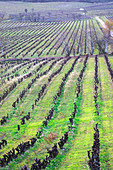There are many, often small, French appellations that are unfortunately far too little known. Sometimes one wonders if the wines wouldn’t be better known (which is important) and easier to sell (even more important) if they used a wider, less precise, but better known appellation. Montlouis is one of those. Have you heard of it? It is a neighbour to Vouvray (a hair’s-breadth better known) in mid-Loire - not big, making only white but ranging from bone-dry to luscious sweet, and including sparkling. All from chenin blanc grapes (one of the most underrated and misunderstood grape varieties) on just 400 ha. The sparkling deserves a special mention due to its originality. Aptly called Pétillant Originel it is made by adding no sugar. That, perhaps, does not sound special, but for sparkling wines it is very unusual: no chaptalisation (sugar added to the must), no liqueur de tirage (sugar added for the second fermentation in bottle), and no liqueur d’expedition (sugar added after dégorgement). Instead they bottle the wine before the fermentation has finished and the bubbles are purely from the natural grapes. Another difference from e.g. champagne is the yield: only 65 hl/ha is permitted (about half of what they do in Champagne). But the most important port of the production are the still whites that, when well done, expresses the wonderful, aromatic, sometimes exotic, sometimes honeyed (even when dry) characters. Providing the grower knows (or dares) to make his wines express the terroir and the grapes. Our favourites are invariably the dry ones. Here are some of the best producers:
Francois Chidaine: Since 10 years he works biodynamically and is one of the leading lights of the appellation. Very fresh and minerally wines, e.g. the Les Choiselle and Le Clos du Breuil (~14€)
Stéphane Cossais: A newcomer to the region, arrived in 2003. (There are several young, new, and ambitious growers here. Land is relatively cheap…) He has only 3 ha. Does some barrel aging of his wines, but that works well with the high acidity. Ha also dares to charge a substantial price for his wines. But they are indeed good. So much better than the others? Try it and decide. E.g Le Volagré or Meuchandelle (both around 20€)
Domaine Levasseur, Alex Mathur: Their dry wine, Les Lumens, is quite full-bodied (barrel fermented and aged for 14 months), more moth filling than most (12€); and excellent sparkling that has a good varietal character (not always the case for sparklers, 12€).
Le Rocher des Violette: Xavier Weisskopf started making Montlousi in 2005 but already makes an excellent, fresh, appely, andminerally wine called La Négrette (13€).
Domaine Frantz Saumon: His Le Clos du Chêne is quite full-bodied, with a ripe-fruit style (ripe, yellow apples) and good finish (23€)
La Taille aux Loups: Jacky Blot is one of the most famous producers in Montlouis. He makes an very good sparkling, called Triple Zéro (0 chaptalisation, 0 liqueur de tirage, 0 liqueur d’expedition – 12€), and a dry Rémus where he harvest in two passes to make sure the grapes have optimal ripeness, giving added concentration. He adds aging on a third new oak barrels giving a substantial wine (12€).
Closerie de Chanteloup: Vincent Guichard’s dry L’Essentiel is well-made (and good value), good structure, minerality, quite light but elegant. (7.50€)
Laurent Chatenay: His Les Maisonnettes has a very good acidity and fruit, very clean flavours with only a minute touch of barrels (9€); Les Hauts de Cangé is much more full-bodied, new oak gives it added body (but actually no oak character) and a touch of residual sugar (11g/l) rounds off the high acidity without making it sweet. Interesting.
Click here for address and more recommendations.
More from BKWine:- Watch our wine videos
- Come on a wine tour
- Wine news on your site
- Subscribe to updates to this blog
- Subscribe to our monthly newsletter
- Put a pin on our map
© Copyright BKWine (text & photo)
Read more...
 Karl Lagerfeld has designed a champagne glass for Dom Perignon (that no longer is the prestige cuvee of Moët & Chandon but a brand all of its own). The glass takes its shape from the breast of the supermodel Claudia Schiffer, or at least it has been inspired by it. We have unfortunately not tried drinking from the glass, nor have we verified its conformance to the original, since we have not seen the mould. Oh, the price tag? A mere $3,150. Including a bottle of Dom Perignon 1995. We wonder if the glass too comes in two-pack? Read more: www.hauteliving.com
Karl Lagerfeld has designed a champagne glass for Dom Perignon (that no longer is the prestige cuvee of Moët & Chandon but a brand all of its own). The glass takes its shape from the breast of the supermodel Claudia Schiffer, or at least it has been inspired by it. We have unfortunately not tried drinking from the glass, nor have we verified its conformance to the original, since we have not seen the mould. Oh, the price tag? A mere $3,150. Including a bottle of Dom Perignon 1995. We wonder if the glass too comes in two-pack? Read more: www.hauteliving.com





















